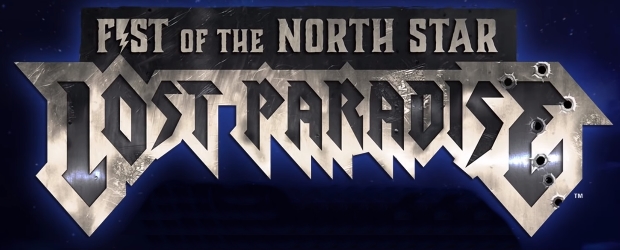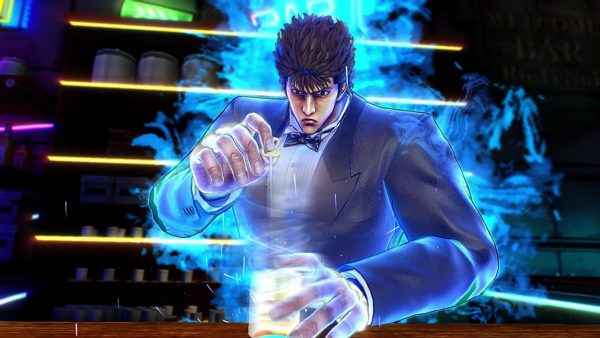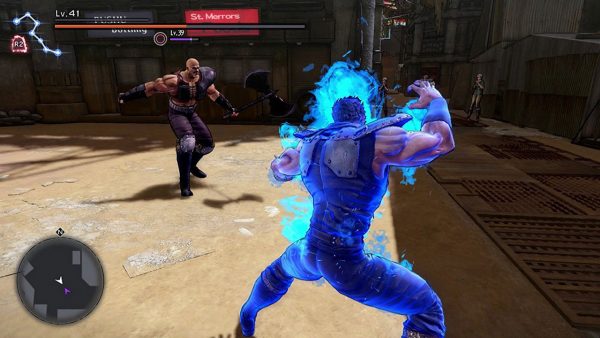Switch to: German
When a Fist of the North Star game was announced last year by SEGA’s Yakuza team, we were pretty excited. As fans of both the original manga and the Yakuza series, a game incorporating the best of both franchises seemed like a recipe for success. A year later, and the end result of this collaboration is a wildly inconsistent game that fails to truly capture the magic of either series.
Previous Fist of the North Star games, like Koei Tecmo’s Ken’s Rage, have tried to cover the manga’s plot to varying degrees of success. Lost Paradise takes a different approach, using characters from the series while telling a completely different story. The basic premise is the same – strong men with inhuman strength and strange martial arts fight in a post-apocalyptic world – and the majority of main characters from Fist of the North Star make an appearance. But the only similarities this story has compared to the original is main character Kenshiro’s backstory, and even then it’s a rather abridged version.
Lost Paradise’s story focuses mainly on the city of Eden, a place where only those who have permission from its leader may enter. Learning that his previously assumed dead lover is still alive, and that she was last sighted in Eden, Kenshiro travels there to find out the truth. What follows is a rather brief journey through both Eden and the surrounding wasteland, where familiar characters come and go without much fanfare. Those that are unfamiliar with the series will likely not even know that certain characters that appear here were even important in the manga, since many of them are introduced quickly and then forgotten about afterwards. It feels like the reason that most of the game takes place in Eden is less to do with storytelling, and more trying to have gameplay be similar to the Yakuza games.
For the most part, exploring Eden and completing substories will feel familiar to Yakuza fans. It may not be as visually appealing as Kamurocho, but it has everything you’d expect: Shops, plenty of minigames and many thugs to fight. In many ways Lost Paradise feels like a reskinned Yakuza title, offering only a few changes here and there outside of combat. There’s even an arcade that eventually houses the same arcade games from Yakuza 0. That’s not to say that everything is reused, and there are a few new additions that we enjoyed. Bartending offers up its own substories, while also giving extra screen time to a variety characters regardless of their importance to the story. Karaoke is unfortunately absent, but in its place is a rhythm game where Kenshiro cures patients using Hokuto Shinken. It’s just a shame that the rest of the new minigames aren’t that enjoyable.
The battle system has a few notable changes compared to the Yakuza series, though not all of them are for the better. Basic combos are the same as always, square for light attacks and triangle for heavy combo ending hits. Instead of Yakuza’s signature heat moves, Kenshiro can use secret techniques after hitting enemies with enough attacks to send them into a stunned state. There are a decent amount of these techniques, most of which taken straight from the source material. It’s great to see these moves recreated so faithfully, but it quickly becomes tiresome after seeing the same moves over and over again. This can be a problem in the Yakuza games as well, but Lost Paradise is lacking the variety of weapon and environmental attacks that the former series has.
There were a few attempts to add more variety to battles, but these also suffer from issues. Landing attacks and secret techniques will fill up the burst meter, which can be used to send Kenshiro into a more powerful state for a few seconds. Burst mode is pretty satisfying, as you send enemies flying and quickly dashing around the place. Unfortunately, a lot of moves are locked behind this mode and the difference in power compared between burst and regular modes is too great. You can’t even jump normally, restricting Kenshiro’s moveset even further for most fights.
Talismans are Lost Paradise’s replacement for weapons, and these are part of a bigger problem the game has. In theory you can equip up to four talismans that mostly give benefits in battle, such as instantly killing a handful of enemies or giving you access to a temporary flamethrower. In practice the long cooldown timers after using a talisman make them near worthless without extensive upgrades. Upgrades require materials, which are mainly gained from driving around the wasteland using one of the worst vehicles we’ve used in a videogame. Sure, you can also upgrade the different parts of your vehicle but that also requires more boring material collecting.
Grinding becomes the only activity after finishing the majority of substories, either to grind for materials or grind the returning hostess club management minigame. The changes to said minigame do help to keep things fresh coming from Yakuza 0, but the amount of grinding required is far too high. Even upgrading Kenshiro will require grinding the arena battles for specific orbs that are used in different upgrade trees. The upgrade system feels like little more than a way to pad the game out more, it would have made more sense to just unlock stat increases and moves as you level up.
Visually Lost Paradise is also a mixed bag. The main cast mirror the manga’s look perfectly – weird proportions and all – but NPCs and environments are generally quite ugly. Again, this is something that is noticeable sometimes in the Yakuza series, but here it’s even more prominent. The wasteland area is the worst offender, being mostly empty and featuring some terrible texture work. It’s also worth noting that many animations have been ripped directly from Yakuza which adds to the rather inconsistent visuals. At least battles, arguable the most important part of the game, look great. Secret techniques are flashy and enemies explode into satisfying fountains of blood.
Conclusion
Fist of the North Star: Lost Paradise is a hard game to recommend at full price. Combat is fun at first, but quickly devolves into one-shotting basic enemies and the lengthy secret techniques quickly outstay their welcome. Everything else feels like Yakuza but worse with a lot more grinding thrown in for good measure. There’s some fun to be had here, but what could have been a fun homage to a fantastic manga ends up being a rather poor imitation of a much better series.







